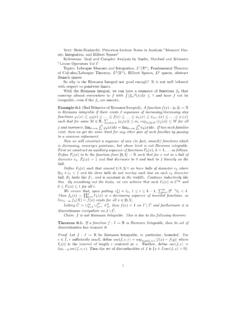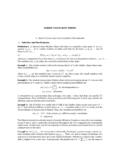Transcription of Math 312 - Markov chains, Google's PageRank algorithm
1 Markov chains: examplesMarkov chains: theoryGoogle s PageRank algorithmMath 312 Markov chains, google s PageRank algorithmJeff JaureguiOctober 25, 2012 Math 312 Markov chains: examplesMarkov chains: theoryGoogle s PageRank algorithmRandom processesGoal: model arandom processin which a systemtransitionsfrom onestateto another at discrete time each time, say there arenstates the system could be timek, we model the system as a vector~xk Rn(whoseentries represent the probability of being in each of thenstates).Here,k= 0,1,2, .., and initial state is~ vectoris a vector inRnwhose entries arenonnegative and sum to 312 Markov chains: examplesMarkov chains: theoryGoogle s PageRank algorithmRandom processesGoal: model arandom processin which a systemtransitionsfrom onestateto another at discrete time each time, say there arenstates the system could be timek, we model the system as a vector~xk Rn(whoseentries represent the probability of being in each of thenstates).
2 Here,k= 0,1,2, .., and initial state is~ vectoris a vector inRnwhose entries arenonnegative and sum to 312 Markov chains: examplesMarkov chains: theoryGoogle s PageRank algorithmRandom processesGoal: model arandom processin which a systemtransitionsfrom onestateto another at discrete time each time, say there arenstates the system could be timek, we model the system as a vector~xk Rn(whoseentries represent the probability of being in each of thenstates).Here,k= 0,1,2, .., and initial state is~ vectoris a vector inRnwhose entries arenonnegative and sum to 312 Markov chains: examplesMarkov chains: theoryGoogle s PageRank algorithmRandom processesGoal: model arandom processin which a systemtransitionsfrom onestateto another at discrete time each time, say there arenstates the system could be timek, we model the system as a vector~xk Rn(whoseentries represent the probability of being in each of thenstates).
3 Here,k= 0,1,2, .., and initial state is~ vectoris a vector inRnwhose entries arenonnegative and sum to 312 Markov chains: examplesMarkov chains: theoryGoogle s PageRank algorithmRandom processesGoal: model arandom processin which a systemtransitionsfrom onestateto another at discrete time each time, say there arenstates the system could be timek, we model the system as a vector~xk Rn(whoseentries represent the probability of being in each of thenstates).Here,k= 0,1,2, .., and initial state is~ vectoris a vector inRnwhose entries arenonnegative and sum to 312 Markov chains: examplesMarkov chains: theoryGoogle s PageRank algorithmCities/suburbsModel a population in the city vs. suburbs. Say~x0= ( , )(meaning 60% live in city, 40% live insuburbs).Given: each year, 5% of city dwellers move to suburbs (therest stay), and3% of suburbanites move to city (the rest stay)Let~xk= (ck,sk).
4 We re told:ck+1= + +1= + ~xk+1=M~xk.~x1= ( , ),~x2= ( , ),~x10= ( , ), ,~xklimits to ( , ).Math 312 Markov chains: examplesMarkov chains: theoryGoogle s PageRank algorithmCities/suburbsModel a population in the city vs. suburbs. Say~x0= ( , )(meaning 60% live in city, 40% live insuburbs).Given: each year, 5% of city dwellers move to suburbs (therest stay), and3% of suburbanites move to city (the rest stay)Let~xk= (ck,sk). We re told:ck+1= + +1= + ~xk+1=M~xk.~x1= ( , ),~x2= ( , ),~x10= ( , ), ,~xklimits to ( , ).Math 312 Markov chains: examplesMarkov chains: theoryGoogle s PageRank algorithmCities/suburbsModel a population in the city vs. suburbs. Say~x0= ( , )(meaning 60% live in city, 40% live insuburbs).Given: each year, 5% of city dwellers move to suburbs (therest stay), and3% of suburbanites move to city (the rest stay)Let~xk= (ck,sk). We re told:ck+1= + +1= + ~xk+1=M~xk.
5 ~x1= ( , ),~x2= ( , ),~x10= ( , ), ,~xklimits to ( , ).Math 312 Markov chains: examplesMarkov chains: theoryGoogle s PageRank algorithmCities/suburbsModel a population in the city vs. suburbs. Say~x0= ( , )(meaning 60% live in city, 40% live insuburbs).Given: each year, 5% of city dwellers move to suburbs (therest stay), and3% of suburbanites move to city (the rest stay)Let~xk= (ck,sk). We re told:ck+1= + +1= + ~xk+1=M~xk.~x1= ( , ),~x2= ( , ),~x10= ( , ), ,~xklimits to ( , ).Math 312 Markov chains: examplesMarkov chains: theoryGoogle s PageRank algorithmCities/suburbsModel a population in the city vs. suburbs. Say~x0= ( , )(meaning 60% live in city, 40% live insuburbs).Given: each year, 5% of city dwellers move to suburbs (therest stay), and3% of suburbanites move to city (the rest stay)Let~xk= (ck,sk). We re told:ck+1= + +1= + ~xk+1=M~xk.~x1= ( , ),~x2= ( , ),~x10= ( , ), ,~xklimits to ( , ).
6 Math 312 Markov chains: examplesMarkov chains: theoryGoogle s PageRank algorithmCities/suburbsModel a population in the city vs. suburbs. Say~x0= ( , )(meaning 60% live in city, 40% live insuburbs).Given: each year, 5% of city dwellers move to suburbs (therest stay), and3% of suburbanites move to city (the rest stay)Let~xk= (ck,sk). We re told:ck+1= + +1= + ~xk+1=M~xk.~x1= ( , ),~x2= ( , ),~x10= ( , ), ,~xklimits to ( , ).Math 312 Markov chains: examplesMarkov chains: theoryGoogle s PageRank algorithmCities/suburbsModel a population in the city vs. suburbs. Say~x0= ( , )(meaning 60% live in city, 40% live insuburbs).Given: each year, 5% of city dwellers move to suburbs (therest stay), and3% of suburbanites move to city (the rest stay)Let~xk= (ck,sk). We re told:ck+1= + +1= + ~xk+1=M~xk.~x1= ( , ),~x2= ( , ),~x10= ( , ), ,~xklimits to ( , ).Math 312 Markov chains: examplesMarkov chains: theoryGoogle s PageRank algorithmCities/suburbsModel a population in the city vs.
7 Suburbs. Say~x0= ( , )(meaning 60% live in city, 40% live insuburbs).Given: each year, 5% of city dwellers move to suburbs (therest stay), and3% of suburbanites move to city (the rest stay)Let~xk= (ck,sk). We re told:ck+1= + +1= + ~xk+1=M~xk.~x1= ( , ),~x2= ( , ),~x10= ( , ), ,~xklimits to ( , ).Math 312 Markov chains: examplesMarkov chains: theoryGoogle s PageRank algorithmMarkov chainsDefinitionAMarkov matrix(orstochastic matrix) is a square matrixMwhose columns are probability chainis a sequence of probability vectors~x0,~x1,~x2, ..such that~xk+1=M~xkfor some Markov : a Markov chain is determined by two pieces of 312 Markov chains: examplesMarkov chains: theoryGoogle s PageRank algorithmMarkov chainsDefinitionAMarkov matrix(orstochastic matrix) is a square matrixMwhose columns are probability chainis a sequence of probability vectors~x0,~x1,~x2, ..such that~xk+1=M~xkfor some Markov : a Markov chain is determined by two pieces of 312 Markov chains: examplesMarkov chains: theoryGoogle s PageRank algorithmMarkov chainsDefinitionAMarkov matrix(orstochastic matrix) is a square matrixMwhose columns are probability chainis a sequence of probability vectors~x0,~x1,~x2.
8 Such that~xk+1=M~xkfor some Markov : a Markov chain is determined by two pieces of 312 Markov chains: examplesMarkov chains: theoryGoogle s PageRank algorithmSteady-state vectorsGiven a Markov matrixM, does there exist asteady-statevector?This would be a probability vector~xsuch thatM~x=~ for steady-state in city-suburb 312 Markov chains: examplesMarkov chains: theoryGoogle s PageRank algorithmSteady-state vectorsGiven a Markov matrixM, does there exist asteady-statevector?This would be a probability vector~xsuch thatM~x=~ for steady-state in city-suburb 312 Markov chains: examplesMarkov chains: theoryGoogle s PageRank algorithmSteady-state vectorsGiven a Markov matrixM, does there exist asteady-statevector?This would be a probability vector~xsuch thatM~x=~ for steady-state in city-suburb 312 Markov chains: examplesMarkov chains: theoryGoogle s PageRank algorithmVoter preferencesSuppose voter preferences (for parties D , R and L )shift around randomly via the Markov matrixA=.
9 20% of supporters of D transition to R each 312 Markov chains: examplesMarkov chains: theoryGoogle s PageRank algorithmVoter preferencesSuppose voter preferences (for parties D , R and L )shift around randomly via the Markov matrixA= . 20% of supporters of D transition to R each 312 Markov chains: examplesMarkov chains: theoryGoogle s PageRank algorithmVoter preferencesSuppose voter preferences (for parties D , R and L )shift around randomly via the Markov matrixA= . 20% of supporters of D transition to R each 312 Markov chains: examplesMarkov chains: theoryGoogle s PageRank algorithmQuestionsQuestions:How do we know a steady-state vector exists?Does a steady-state vector always have nonnegative entries?Is a steady-state vector unique? Can you ever guarantee it?Does the Markov chain always settle down to a steady-statevector?
10 Math 312 Markov chains: examplesMarkov chains: theoryGoogle s PageRank algorithmQuestionsQuestions:How do we know a steady-state vector exists?Does a steady-state vector always have nonnegative entries?Is a steady-state vector unique? Can you ever guarantee it?Does the Markov chain always settle down to a steady-statevector?Math 312 Markov chains: examplesMarkov chains: theoryGoogle s PageRank algorithmQuestionsQuestions:How do we know a steady-state vector exists?Does a steady-state vector always have nonnegative entries?Is a steady-state vector unique? Can you ever guarantee it?Does the Markov chain always settle down to a steady-statevector?Math 312 Markov chains: examplesMarkov chains: theoryGoogle s PageRank algorithmQuestionsQuestions:How do we know a steady-state vector exists?Does a steady-state vector always have nonnegative entries?Is a steady-state vector unique? Can you ever guarantee it?



















